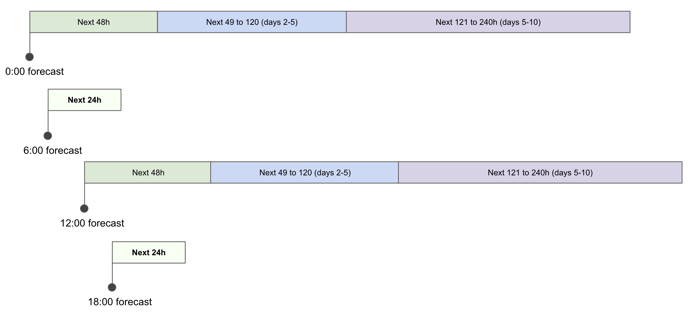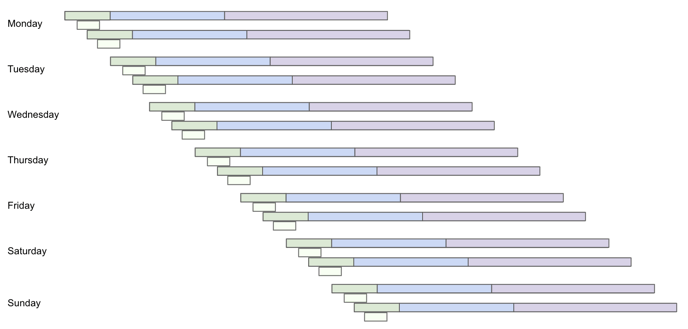An overview of forecast resolution, range, update times, issuance times, and lead times.
Spire Weather owns and operates every stage of the forecast value chain, from satellites and ground stations to the data assimilation process and global forecast model.
As a result, Spire Weather is able to offer 1/8th-degree horizontal global resolution, which is about 12 km or 7.4 miles. This means that 1 grid cell is approximately:
- 12 km x 12 km
- 144 km^2
- 14400 hectares
- 35583 acres
Forecast Ranges and Refresh Rates
Forecasts from the past 3 days are always available via the APIs, and additional historical forecasts can be made available upon request.
Spire Optimized Point Forecast
Spire's Optimized Point Forecast is updated every hour.
Spire Global Forecast
Spire's 24 hour forecasts are issued 4 times per day, at 00:00, 06:00, 12:00, and 18:00 UTC. This forecast data has hourly granularity, meaning there are 1-hour intervals between forecast lead times.
Spire's 15 day forecasts are issued 2 times per day, at 00:00 and 12:00 UTC.
The first 48 hours of the forecast have 1-hour intervals between lead times.
The first 5 days of the forecast have 3-hour intervals between lead times.
The full 15 days of the forecast have 6-hour intervals between lead times.
All of Spire's forecast values are consistent, with the only difference being how the forecast model run is sliced up into different lead times. As a result, the 2 day forecast for 12 UTC would contain the same values whether you’re querying with 1 hour intervals, 3 hour intervals, or 6 hour intervals.
Forecast Dissemination Schedule
Forecast updates occur over a range of time and data is made available in the API on a rolling basis. Nominally, forecasts should complete updating in the API by the following times, though this is not a guarantee and it is possible for forecast data dissemination to be slightly more delayed if there are delays from upstream data partners.
- 01:00 UTC for the previous day's 18:00 issuance time
- 07:00 UTC for the 00:00 issuance time
- 13:00 UTC for the 06:00 issuance time
- 19:00 UTC for the 12:00 issuance time
Daily Forecasts

NOTE: Spire's Global Forecasts extend out to 15-Days
Weekly Forecasts

It's worth emphasizing that "update time", "issuance time", and "lead time" all refer to separate things.
The update time is when a forecast completes updating, around 7 hours after the issuance time.
Issuance times always correspond to 00:00, 06:00, 12:00, or 18:00 (UTC).
Lead times refer to the valid time components of the forecast itself. In other words, lead times represent the length between the issuance time and the occurrence of the predictions.
For a short-range forecast with an issuance time of 06:00 UTC, the first lead time is 06:00 UTC, which is the "earth state" of the global forecast model at that time.
The +1h lead time is 07:00 UTC and represents the "first forecasted state".
The +2h lead time is 08:00 UTC and represents the second forecasted state.
The +3h lead time is 09:00 UTC and represents the third forecasted state -- and so on.
For more information on the general weather forecast process, please see here.
For information on downloading multiple forecast files via the API, please see here.